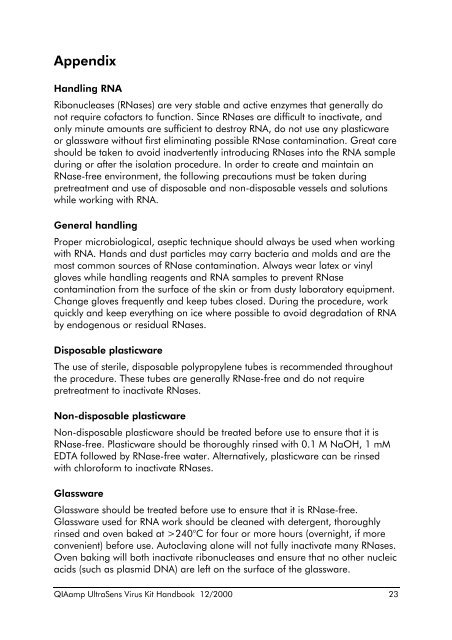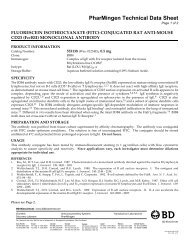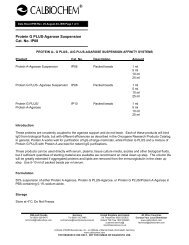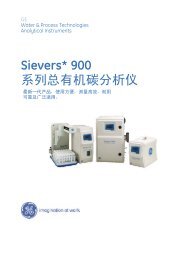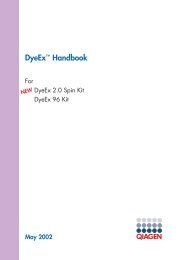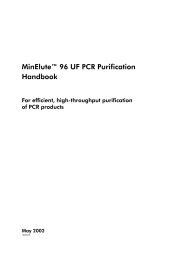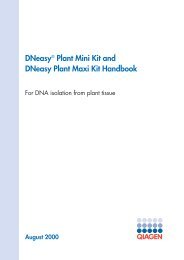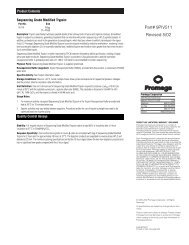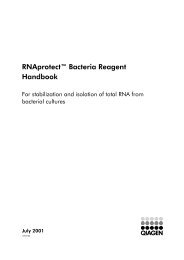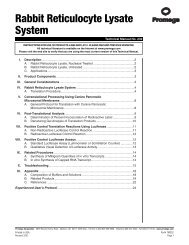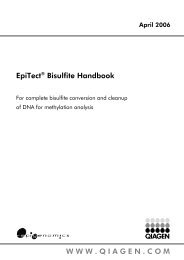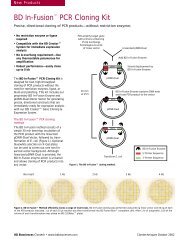QIAamp UltraSens Virus Kit Handbook 12/00 (PDF
QIAamp UltraSens Virus Kit Handbook 12/00 (PDF
QIAamp UltraSens Virus Kit Handbook 12/00 (PDF
Create successful ePaper yourself
Turn your PDF publications into a flip-book with our unique Google optimized e-Paper software.
Appendix<br />
Handling RNA<br />
Ribonucleases (RNases) are very stable and active enzymes that generally do<br />
not require cofactors to function. Since RNases are difficult to inactivate, and<br />
only minute amounts are sufficient to destroy RNA, do not use any plasticware<br />
or glassware without first eliminating possible RNase contamination. Great care<br />
should be taken to avoid inadvertently introducing RNases into the RNA sample<br />
during or after the isolation procedure. In order to create and maintain an<br />
RNase-free environment, the following precautions must be taken during<br />
pretreatment and use of disposable and non-disposable vessels and solutions<br />
while working with RNA.<br />
General handling<br />
Proper microbiological, aseptic technique should always be used when working<br />
with RNA. Hands and dust particles may carry bacteria and molds and are the<br />
most common sources of RNase contamination. Always wear latex or vinyl<br />
gloves while handling reagents and RNA samples to prevent RNase<br />
contamination from the surface of the skin or from dusty laboratory equipment.<br />
Change gloves frequently and keep tubes closed. During the procedure, work<br />
quickly and keep everything on ice where possible to avoid degradation of RNA<br />
by endogenous or residual RNases.<br />
Disposable plasticware<br />
The use of sterile, disposable polypropylene tubes is recommended throughout<br />
the procedure. These tubes are generally RNase-free and do not require<br />
pretreatment to inactivate RNases.<br />
Non-disposable plasticware<br />
Non-disposable plasticware should be treated before use to ensure that it is<br />
RNase-free. Plasticware should be thoroughly rinsed with 0.1 M NaOH, 1 mM<br />
EDTA followed by RNase-free water. Alternatively, plasticware can be rinsed<br />
with chloroform to inactivate RNases.<br />
Glassware<br />
Glassware should be treated before use to ensure that it is RNase-free.<br />
Glassware used for RNA work should be cleaned with detergent, thoroughly<br />
rinsed and oven baked at >240°C for four or more hours (overnight, if more<br />
convenient) before use. Autoclaving alone will not fully inactivate many RNases.<br />
Oven baking will both inactivate ribonucleases and ensure that no other nucleic<br />
acids (such as plasmid DNA) are left on the surface of the glassware.<br />
<strong>QIAamp</strong> <strong>UltraSens</strong> <strong>Virus</strong> <strong>Kit</strong> <strong>Handbook</strong> <strong>12</strong>/2<strong>00</strong>0 23


